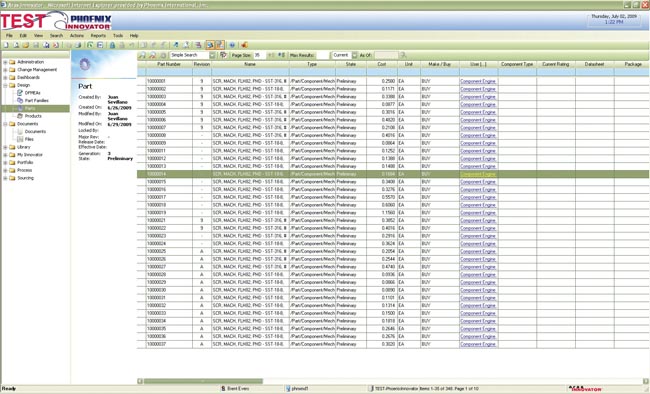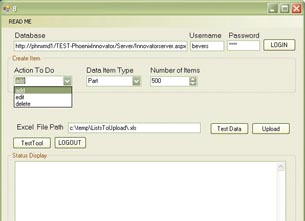Latest News
April 1, 2010
By Brent Evers
This is the final in a series of three articles on Phoenix International’s internal implementation of Aras Innovator. This segment discusses some of the realities of installation and configuration of the database, uploading of all Phoenix parts, and how its engineers are becoming day-to-day users of the system. Please read Part 1 here and Part 2 here.
Engineering generates a lot of data. Getting it all to the point where it can be managed well is no simple matter. Phoenix reviewed and generated parametric data for approximately 8,000 parts and 7,200 documents in preparation for uploading to Innovator. The process was time consuming and tedious, but for the first time, we have a handle on where everything is, how it is used, who modifies it, and when it is revised.
 The process of implementing a PLM system forced Phoenix to take a close look at its business processes. To evaluate its new PLM system, it used multiple test databases for development and implementation, preventing errors and contamination of our real data. |
Perhaps even more important, the process of implementing a PLM system forced us to take a close look at how that system operated out of the box in comparison to our own business processes. This led to significant revisions of our processes, some in support of Innovator, and others just because we learned a better way to do things. At times, the debate has been vigorous—and it has been rewarding to see engineers take ownership of the process to make sure that we emerge a stronger, more capable engineering team.
Implementation Results and Gains
To evaluate the benefits Phoenix gained from the effort, we needed to review our initial goals and requirements. One of those goals was to secure a single process for development and documentation of all engineering projects. Innovator provides a framework that ensures every engineering project uses the same process for development, regardless of the project’s size or scope or whether it is for an internal or external customer. The processes are rigorous enough to ensure a quality, cohesive product across multiple projects, but flexible enough to allow for rapid response, demanding customer requirements, and tight budgets.
We also aimed for a single repository (vault) for all project data. All document data (e.g., CAD data, photos, MS Office documents, etc.) is vaulted in Innovator. This is augmented through the use of deeply integrated CAD connectors. At Phoenix we developed our own ECAD connection, but will most likely purchase an MCAD connection. The only exception to this single repository is that OrCAD uses an additional repository for datasheets that are called up within the tool. In the future, we hope to have OrCAD draw these from the Innovator vault as well.
 Aras Innovator offers a single source of data for all associated part information. This is augmented via CAD connectors. |
We had to have the ability to establish and revise a product structure. Innovator is built on an SQL database that provides a rich set of relationships between items. Product structures are built on the relationships of parts and assemblies. Aras Innovator greatly extends the concept of relationships to all supporting documents, including 3D CAD models, schematics, PCB layouts, CAM/MFG files, software, mechanical drawings, assembly instructions, test plans, photos, requirements documents, etc.
Phoenix wanted the ability to control all documentation. Innovator provides revision control for all data in and out of the system, and in and out of the document vault through the engineering change process.
A formal document (drawing) change process was also a must. Innovator’s control of documents is via a customizable change process that tracks revision of all documents, parts, assemblies—everything, actually.
In addition, we had to have the ability to pack and go with all project data. This enables vehicle operators to pull everything they need prior to a job and take it to an offshore environment where a connection to Phoenix’s network is likely to be nonexistent. Phoenix has not yet completed this, but our initial investigation indicates that this capability is possible.
Cost Outlay
The out-of-pocket costs to implement Aras were zero. This assumes of course that you have the hardware and software infrastructure in place to run the database application. The system runs on MS SQL Server, but can also run on SQL Server Express, which provides a quick-and-dirty method to get the system up and running with minimal outlay for testing and evaluation.
The bulk of the cost, like any PLM system, will come in implementation, and the extent of that will largely depend on how well the company has organized its data to date and the need to tailor Innovator’s baseline processes. In Phoenix’s case, this meant a lot of data cleanup and research. By adding a rich set of parameters to all part data, we will significantly improve our part selection and commonality in the future.
Customizing Innovator was also a significant effort, but that was largely driven by our goal of developing a rich data set, not just a repository. It helped that we have talented software engineers on our staff, but that is not a requirement. We kept a couple of engineers busy part-time for a few months getting Aras Innovator up and running. It became clear that the sooner an engineering group embarks on this process, the less it will cost. Much of our implementation was in ‘repair’ work—cleaning up and taking down old data that had never been properly stored.
Going Forward with the System
Embarking on an enterprise-wide PLM implementation is a significant commitment of effort and resources. Making that commitment to a free or open-source solution only adds to the skepticism of many managers and IT departments. Aside from the obvious benefits of no out-of-pocket upfront costs and no licensing or user costs, we have noted real benefits in implementing Aras Innovator.
Aras Innovator is freely available and the solutions are governed by the OSI approved Ms-PL license. The source code to the core application is not available to non-paying customers, but was not needed in our implementation. There is some debate that this model does not meet the definition of open source. The bottom line for Phoenix was that we didn’t need to pay a dime out of pocket to capitalize on the availability of a ready-for-prime-time, ready-to-go PLM system.
Innovator is also a real out-of-the-box solution. The documentation is sufficient, the platform is stable and community support is growing.
Nearly all of our work was in preparing data and modifying the base solution to suit our needs, CAD tools, and processes. An organization that starts out using Innovator from day one, and adopts the default processes, would not face these issues. The sooner the Innovator solution is adopted, the less the impact on the organization.
It can also be implemented completely independent of Aras assistance. In fact, for small to mid-sized organizations, this might be the preferred method. We learned a lot and implemented the system we needed. If we had paid for upfront support costs, we might have saved some internal costs and might have implemented Innovator faster.
In our case, in-house implementation proved to be the right vehicle because it forced us to determine—as we went along—exactly what we needed in a PLM system. But now that we know our needs, and as our use of Innovator becomes more sophisticated, we will review Aras’ support services to see how they might fit our future growth of the system.
Aras Innovator is a big system and we are not using all its capabilities. Right now we have the basics up and running—all of our design data and documents captured, product structures in place, documents under control, and a change process working—but we intend to continue to expand our use of Innovator’s project management capabilities, integrate it with our Microsoft Dynamics accounting system, investigate the use of variants, and expand its utility to other corporate users beyond engineering (e.g., purchasing and production).
Phoenix exceeded several long overdue goals by implementing Aras Innovator while learning a lot about our organization in the process. Implementing a homebrew PLM system with Aras Innovator isn’t wholly free, but it’s about as close as you can get. The rewards of implementing this robust, stable, and well-supported system are immediately tangible and we expect our PLM system to reveal even more benefits in the future.
More Info:
Aras Corp.
Phoenix International Holdings
Brent Evers is the engineering manager at Phoenix International Holdings, Inc. Send comments about this article to [email protected].
Subscribe to our FREE magazine, FREE email newsletters or both!
Latest News
About the Author
DE’s editors contribute news and new product announcements to Digital Engineering.
Press releases may be sent to them via [email protected].






